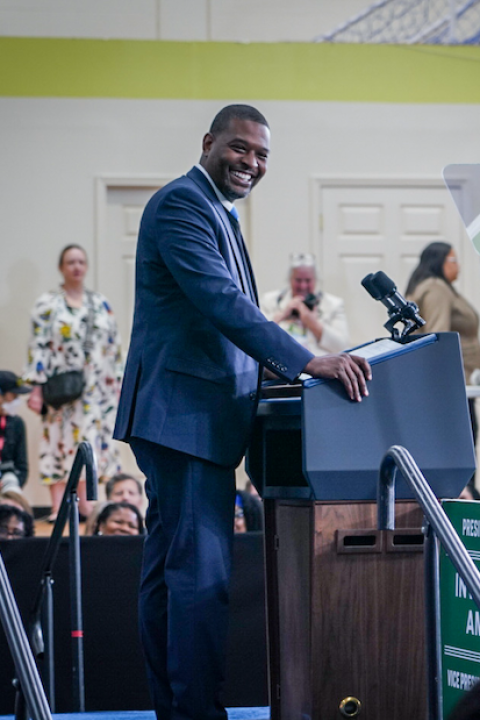
(Image credit: Vasyl/Adobe Stock)
This story about discussing race at work is part of Let's Talk About It, a guest-contributed column exploring how to navigate hard conversations and complex challenges in the workplace. If you're interested in contributing your perspective to this column, please get in touch with us here.
Many of us have been there. We’re in a workplace meeting and someone starts talking about the importance of having “uncomfortable conversations.” You don’t have to go far before stumbling into the buzz about being “authentic” and “living your truth” as part of your professional development and career advancement.
“Difficult conversations” is a jargon-y catchphrase that many leaders endorse as part of their approach to managing teams and analyzing anything from disastrous product launches to dumpster-fire company mergers. Self-aware organizations are supposed to courageously embrace candid feedback and radical truth. Well, that’s until that unvarnished truth is about race, diversity, unconscious bias, discrimination and equity.
Interest in transparent conversations involving race is often mere performative lip service.
Wading through discomfort quickly comes to a screeching halt when confronting racial biases on an individual or organizational level. And those speaking the truth are often gaslit, sidelined, experience hostility, and are eventually shown the door. These are defensive knee-jerk reactions to feeling threatened since taking an honest look at racism challenges people’s sense of self and whether they view themselves as a “good person” or “racist.”
A line from the Hollywood film "American Fiction" sums up the challenges around discussing racism. “White people think they want the truth, but they don’t. They just want to feel absolved.”
Suffering from not-here syndrome: Why white people struggle
If a company can deconstruct failed business decisions, why can’t it tackle failures in recruiting and retaining people of color? Or why it’s being sued for racial discrimination? Why there are few executives of color? Why a particular key leader has high turnover with talent of color?
Discussing race is deeply personal. Many lack basic skills and cultural intelligence to not fumble. They allow fears of being judged or an allergy to self-analysis to prompt toxic reactions. Except difficult conversations inherently involve taking an inventory of your mindset, values and decisions.
For white people to have more productive conversations where they can learn and grow, and that minimize marginalizing people of color, they must transition away from white exceptionalism (i.e., an inability to look inward and acknowledge when leaning into racism). They should expand their definition away from seeing racism only in extreme forms (e.g., hate crime perpetrators) where it always manifests elsewhere and never at home.
The benchmark for what’s racist isn’t about “hearts and mind” ideologies where we theoretically believe in racial equality. Nor is it about intentions. Intent isn’t a shield from engaging in racism. The barometer is tied to the impact of your actions and choices – including how you behave and what you say or don’t say when discussing race. People of color care less about what white people feel or intend and more about how white people treat or harm them.
You must have a growth mindset to evolve and have productive conversations about racism, bias and discrimination. You should arrive capable of managing your own feelings while accepting and admitting hard truths about yourself.
Best practices for white people: What to do
Respect is the critical starting, middle and end point in cross-racial interactions. If you can’t modulate your behavior and self-censor to avoid subjecting people of color to verbal trauma, micro-aggressions and demoralizing overt racism, then you’re not ready for substantive and meaningful interactions with people of color. Here are some things to keep in mind:
- Bring kindness, compassion, empathy, patience and civility.
- Arrive ready, willing, and able to prioritize the views and feelings of people of color above your own.
- Insist on race-centered conversations, avoiding distractions discussing gender, sexuality, class and other -isms. Focus strategically on racism, even if exploring intersectionality with race, to avoid hijacking the topic. The goal isn’t to use people of color as vehicles for other groups’ progress while ignoring the need to tackle race.
- Come willing to trust by believing what you’re told by people of color. Accept what they say is racist as a fact instead of questioning or pushing back.
- Avoid interrupting even when excited or wanting to support an idea. Avoid steamrolling and hogging up space. No one wants to speak with those seeking to hear their own voice.
- Leave your debate skills at the door. It’s a conversation, not a moot court competition. People of color shouldn’t feel attacked, challenged, worn out and depleted from spending time with you.
- Create space for people of color to share their views and feelings. If you notice others being dismissive of them or white colleagues engaging in offensive or micro-aggressive behavior, strategically shift the discussion to limit the negative impact on participants of color. This supports voices of color.
…. and what not to do
At the core of why conversations are often unsuccessful is because many white people come ill-prepared to navigate their own feelings and those of people of color. Here are some things to leave behind:
- Unrealistic expectations: Don’t expect to solve racism or repair relationships in one discussion, or for marginalized groups to be devoid of emotions, anger and resentment. The goal isn’t to create false unity or reconciliation, which in this context is often code for sweeping racism under the rug and making white people feel better without accountability.
- Forgiveness: Don’t anticipate exoneration or manipulate forgiveness when it’s not yours to give.
- Hostages: Avoid forcing people of color into discussions on racism when they’re not interested, expecting them to reveal intimate, personal stories when you have no right to this information.
- Inquisition: Avoid asking questions about unimportant details or focusing too much on information that misses the big picture.
- Comedy central: Don’t tell jokes. Period.
- Defensiveness: When your behavior is called out as being prejudiced or topics hit home, don’t get defensive. The only preemptive move is not to offend in the first place. Own your behavior and don’t express hostility, shut down or make excuses.
- White victimhood: Avoid talking about your own personal struggles. Don’t make this about you! This is invalidating and negates the impact of race. People of color don’t want to hear about hardships you’ve overcome, making them feel ignored and relegated to the service road.
- White tears and fragility: Avoid crying or becoming overly emotional when struggling to cope with mirrors held to your face or confronting racism. People of color do not appreciate discussions being commandeered. It’s coddling and prioritizes your emotional needs at their expense. While you’re important, the larger issue is you’re always important and they’re not. You must create space for them to speak and you to learn and develop better coping skills.
- White grievance: Don’t raise gripes about perceived wrongs to white people. White people still hold most of the political and societal power as the dominant group. If you feel maligned as a white person, it’s time to recalibrate your outlook. This thinking shows you’re not getting it and there’s a vast sea of misunderstanding between you and people of color.
By following this advice, you’ll be better prepared to have more transparent, difficult conversations around race while also limiting shutting down and tuning out. Understanding how to create and respect boundaries at work is crucial for creating a healthy and diverse modern workplace that focuses on employee well-being and psychological safety for colleagues of color. These tips can support people of color feeling respected and equally free to “live their truth” like their white coworkers.

Fatimah Gilliam is author of Race Rules: What Your Black Friend Won't Tell You and is Founder and CEO of The Azara Group, a strategy consulting firm specializing in Diversity & Inclusion.














